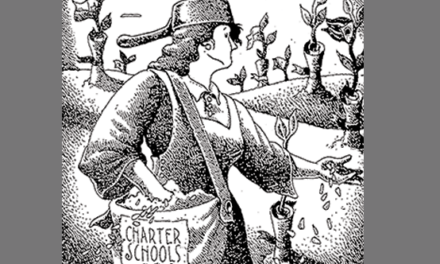Just going through the motions is not enough to make a partnership effective. The right conditions and mindsets are necessary.
Many educators want to use research to help them make decisions about teaching and learning. Yet, when they turn to research for support, they often find that it focuses on issues that are more relevant to researchers than practitioners. When researchers do focus on issues that practitioners consider pressing, their guidance often comes too slowly to be useful at the moment of need (Penuel et al., 2017). Nor, when practitioners and researchers do find a way to connect, is there any guarantee that the research findings will influence decisions about policy and practice.
One popular strategy for bridging research and practice is research-practice partnerships (RPPs). As described elsewhere in this issue (Coburn, Penuel, & Farrell, 2021), RPPs are long-term collaborations designed to improve and transform educational practice by enabling researchers and practitioners to share their diverse perspectives and expertise. From a growing body of research on RPPs, we know that productive interactions in RPPs contribute to changes in when and how educators integrate research in their decisions (Penuel et al., 2020). Under some circumstances, research and interventions developed and shared through an RPP can contribute to real shifts in district routines and policies (Farrell, Coburn, & Chong, 2019) and have been associated with improved student outcomes (Snow, Lawrence, & White, 2009). In other words, through partnerships, research can affect practice.
Yet, RPPs are not a silver bullet. Working across boundaries to organize and maintain RPPs requires resources, energy, and a lot of behind-the-scenes effort (Donovan, Snow, & Daro, 2013). Participants might have differing expectations of roles and responsibilities, which can lead to confusion, mistrust, or conflict (Farrell, Harrison, & Coburn, 2019). Even long-standing RPPs can run into bumps in their work together because of leadership turnover, different paces of work, or a lack of participants with decision-making authority (Farrell et al., 2018). So what conditions help RPPs be more successful in shaping district policies and practices?
To answer this question, we — two directors of RPPs (Laura Wentworth and Michelle Nayfack) and a researcher who studies RPPs (Caitlin C. Farrell) — began exploring the long-standing partnership between Stanford University Graduate School of Education (Stanford GSE) and San Francisco Unified School District (SFUSD). Established in 2009 with support from the SFUSD superintendent and Stanford GSE dean, and currently directed by Laura Wentworth, the partnership has 20-30 active projects happening at any given time. (Learn more about the RPP at http://stanfordsfusd.org.)
We did not set out to conduct formal research on RPPs; rather, our goal was to collect evidence that would help us improve the director’s own work. We selected 37 projects that had been conducted from 2013 to 2019 under the Stanford-SFUSD umbrella and identified the key district staff and researchers involved in the project; looked for conditions that could shape success (e.g., characteristics of the researchers or practitioners, behaviors involved in their work together); and determined whether the project contributed to a shift in district policy or practice.
Conditions that help RPPs succeed
Our examination of the RPP projects led us to three main insights about the conditions under which research projects can contribute to meaningful shifts in school district policies and practice.
Establishing times and places for researchers and practitioners to make sense of research findings is necessary, but not sufficient.
Routinely bringing researchers and educators together to discuss research ideas can support changes in policy and practice. During these gatherings, educators have opportunities to make sense of research findings, pose questions of researchers, and consider possible courses of action based on the research. At the same time, researchers are able to gain insight from educators that can shape their research questions.
The role of such routines was evident when SFUSD administrators Elizabeth Hull Barnes, Alisa Brown, Alison Ellsworth, Ho Nguyen, and Emma Treviño partnered with Stanford professors Hilda Borko and Janet Carlson and their research team to build the capacity of mathematics teacher leaders to support instructional improvement in middle schools. The Stanford researchers and district leaders codesigned and conducted professional learning for SFUSD teacher leaders using a method of analyzing instructional practice called the problem-solving cycle.
Central to these efforts were routine meetings where SFUSD leaders and Stanford researchers collaborated to design the work and consider findings from research. For instance, a team of SFUSD central administrators, teachers on special assignment, and Stanford researchers mapped out how they would work together, discussed research findings, and talked about what these findings meant for their work together. During these conversations, SFUSD leaders discussed how these findings should lead them to adjust the design and content of teacher professional learning, and insights from the district leaders helped researchers sharpen their analysis and research insights.
The Stanford researchers and SFUSD leaders also presented their findings together at conferences, and planning these presentations gave them further opportunities to make sense of the findings together in preparation for sharing them with a larger audience. The team had informal interactions, including emails, texts, and weekly or biweekly meetings for immediate work. These more frequent communications allowed researchers to support the district decision makers in ways that matched the cadence and pace of district work. (More information about the project is available at https://cset.stanford.edu/problem-solving-cycle-and-teacher-leadership-preparation.)
Across the 37 projects involving Stanford and SFUSD, all the projects that brought about changes in policy and practice had these kinds of routines for collaboration in place. However, engaging in these routines alone was not enough to guarantee an impact on policy and practice.
The stances of the researchers and practitioners toward the partnership matter.
The participants in research projects that contributed to changes in policies and practices had what we call a “productive stance toward partnering.” The researchers in these projects were seen as open-minded, communicative, and empathetic when working with their practice partner. They demonstrated a willingness to say “I don’t know” and were flexible in making adjustments to their work. The district leaders demonstrated an open orientation toward data, inquiry, and evidence, and they had sufficient decision-making authority to link the research efforts to ongoing district initiatives.
One example of this essential combination of conditions occurred when Christina Wong, SFUSD special assistant to the superintendent, and her colleagues in the Multilingual Pathways Department worked with (now emeritus) Stanford professor Claude Goldenberg to improve the district’s instruction for English learners (ELs). Specifically, Wong needed evidence on the effectiveness of SFUSD’s EL instruction to ensure that the district was living up to the goals of a consent decree stemming from the 1974 Supreme Court case Lau v. Nicols. Over the course of a year, Wong, Goldenberg, and their teams produced an observation protocol (available at http://bit.ly/SFUSDprotocol) that the district used to collect information on the implementation of EL instruction across classrooms, including bilingual and English-only classrooms.
This project ultimately changed SFUSD’s practice for tracking its implementation of the types of instruction ELs received. This project, and a number of others, helped Wong and her colleagues improve the outcomes for SFUSD English learners and ultimately to be released from the federal consent decree in June 2020. However, the project lacked the resources to collect an additional year’s worth of data to verify their initial findings, which meant that, although the findings were useful for Wong’s policy and practice decisions, they did not produce research that could be shared more broadly.
This partnership illustrates the benefits that can emerge when district leaders with authority and an inquiry stance who actively align research to district priorities are paired with researchers who take a partnership stance. On the district side, Wong had the authority to take action when research pointed in certain directions. Wong also had an open stance to evidence and inquiry, as evidenced in her pursuit of a partnership with Goldenberg, whose expertise in instruction for English learners and recent experience developing observation protocols (available at https://claudeg.people.stanford.edu/cqell) tied in nicely with SFUSD priorities. On the researcher side, Goldenberg had a history of connecting his work to issues central to practice partners, felt comfortable engaging with the SFUSD leaders, and valued their insights and ideas during the research production process. Goldenberg was an active participant in developing the protocol: He observed and collected data in classrooms, and, during the bimonthly meetings with SFUSD, he asked questions and debated with district leaders over the characteristics of high-quality EL instruction.
Policy change efforts can be derailed in the absence of certain organizational conditions.
As important to understanding when changes do occur is an understanding of when policy and practice change do not occur. In the project we examined, we identified two different ways in which change efforts got derailed.
First, district policy or practice failed to change when the researcher(s) did not have a productive partnership stance. In some projects, Stanford researchers had trouble balancing their vision for the research questions and design with the district’s goals and pace of work. In these instances, researchers did not complete analyses in time to influence policy and practice decisions, or researchers produced analyses that did not respond to the issues district leaders were attempting to address.
In the other derailed projects, district leaders had authority but did not integrate research into district initiatives. In some cases, leaders spent a lot of time up front helping to design and execute research efforts, but they spent less time integrating the research findings into their policy and practice discussions. This tended to occur when the research findings were not what the leaders expected, when the research findings were not viewed as useful, or when leaders wanted additional evidence to bolster their understanding before making a decision.
Developing the right conditions
As our review of RPP projects suggests, having an RPP structure in place is not enough. To actually change policies and practices, those partnerships must meet certain conditions. To best position RPPs to meet those conditions, we have three recommendations for researchers, school district leaders, and other RPP stakeholders.
Make time and space to engage around research findings, ideally in ways that are synchronized with district policy-making efforts.
Creating time and space for educators and researchers to make sense of research findings together increases the likelihood that research can inform and influence educators’ decisions and district policies. These spaces for interaction can create opportunities for learning, as people engage with, and make meaning of, research-based ideas and tools within their own context and based on their own past experiences (Penuel et al., 2015). Further, making educational policy involves navigating a complex field of constraints and demands, and these interaction spaces can create opportunities for leaders and researchers to think together about how research findings interact with other considerations, including professional judgment, personal experiences, values, data, community demands, availability of resources, and other constraints (Huguet et al., in press). This strategy likely means that researchers will need to be more comfortable sharing work-in-progress instead of waiting for final results, and district leaders will need to understand that these preliminary findings might change with additional data collection and analysis.
Support district leaders with opportunities, training, and mentorship about how to connect research and RPP efforts to ongoing district work.
In the case of Stanford-SFUSD, research projects that saw changes in policy and practice involved teams with open mindsets toward evidence use, inquiry, and data, and who were also actively trying to connect research findings to district efforts. Yet, based on our experiences in the field, not all district leaders are prepared for this kind of orientation and set of strategies. To its credit, SFUSD provides job-based professional development to help its aspiring and current central and site leaders develop an inquiry mindset and build their confidence integrating evidence and research into district initiatives. Further, educational leaders can help nurture other participants’ positive stances toward partnering, cultivate an inquiry stance in their peers, and support their colleagues’ engagement with research in their work.
Support researchers in connecting their studies to pressing policy and practice issues.
This work also points to a need for researchers to develop a productive orientation toward collaborative research and partnership. For instance, given research and practice partners’ differing priorities and time lines, researchers need to be flexible in their work and empathetic about partners’ changing needs and contexts. Researchers may also need training in developing initial relationships, learning how to jointly decide on partnership aims, deepening their understanding of partners’ organizational or community context, understanding power dynamics and political realities, and building strong listening, communication, and facilitation skills.
Recognizing that some researchers might need formal training in these areas, Stanford Graduate School of Education has launched a set of courses leading to a Certificate in Partnership Research. Courses in this program focus on the skills involved in partnering and the inevitable challenges that arise while working in RPPs. Junior scholars can also get additional on-the-ground training through apprenticeships and mentorships on projects. For example, Hilda Borko and Janet Carlson’s work on the problem-solving cycle involves a multigenerational team, in which early graduate students are mentored by more senior graduate students, postdoctoral fellows, and research associates. Early-career scholars can also receive support in how to develop more collaborative research projects through a newly formed network for graduate students called Rising Education Scholars Helping Advance Partnerships and Equity (RESHAPE; @reshapenetwork on Twitter).
Our hope is that efforts like these will help scholars develop research projects that actually make a difference for education practitioners. Even those educational leaders who are open to partnership and have an inquiry mindset are pressed for time, resources, and capacity. Therefore, any energy they spend in a research-practice partnership needs to be worth the investment. Following these recommendations can help all partners ensure that the bridges between research and district policy and practice remain strong and that crossing them is worth the journey.
References
Coburn, C.E., Penuel, W.R., & Farrell, C.C. (2021). Fostering educational improvement with research-practice partnerships. Phi Delta Kappan, 102 (7), 14-19.
Donovan, M.S., Snow, C.E., & Daro, P. (2013). The SERP approach to problem-solving research, development, and implementation. In B. Fishman, W.R. Penuel, A.R. Allen, & B. Cheng (Eds.), Design-based implementation research: Theories, methods, and exemplars (Vol. 112, pp. 400–425). National Society of the Study of Education Yearbook.
Farrell, C.C., Coburn, C.E., & Chong, S. (2019). Under what conditions do school districts learn from external partners? The role of absorptive capacity. American Educational Research Journal, 56 (3), 955-994.
Farrell, C.C., Harrison, C., & Coburn, C.E. (2019). “What the hell is this, and who the hell are you?” Role and identity negotiation in research-practice partnerships. AERA Open, 5 (2), 1-13.
Farrell, C.C., Davidson, K.L., Repko-Erwin, M., Penuel, W.R., Quantz, M., Wong, H., Riedy, R., & Brink, Z. (2018). A descriptive study of the IES Researcher-Practitioner Partnerships Program: Final report (Technical Report No. 3). National Center for Research in Policy and Practice.
Huguet, A., Coburn, C.E., Farrell, C., Allen, A-R., Coburn, C.E., & Kim, D. (in press). Constraints, values, and information: How leaders in one district justify their positions during instructional decision making. American Educational Research Journal.
Penuel, W.R., Allen, A.-R., Coburn, C.E., & Farrell, C.C. (2015). Conceptualizing research-practice partnerships as joint work at boundaries. Journal of Education for Students Placed at Risk, 20 (1-2), 182-197.
Penuel, W.R., Briggs, D.C., Davidson, K.L., Herlihy, C., Sherer, D., Hill, H.C.,. . . Allen, A.R. (2017). How school and district leaders access, perceive, and use research. AERA Open, 3 (2), 1-17.
Penuel, W.R., Farrell, C.C., Anderson, E.R., Coburn, C.E., Allen, A.-R., Bohannon, A.X., . . . Brown, S. (2020). A comparative, descriptive study of three research–practice partnerships: Goals, activities, and influence on district policy, practice, and decision making. National Center for Research in Policy and Practice.
Snow, C.E., Lawrence, J., & White, C. (2009). Generating knowledge of academic language among urban middle school students. Journal of Research on Educational Effectiveness, 2 (4), 325-344.
ABOUT THE AUTHORS

Caitlin C. Farrell
CAITLIN C. FARRELL is an associate research professor at the University of Colorado Boulder School of Education.

Laura Wentworth
LAURA WENTWORTH is director of the Stanford University-San Francisco Unified School District Partnership, a program of California Education Partners, San Francisco, Calif.

Michelle Nayfack
MICHELLE NAYFACK is the associate director of research-practice partnerships at California Education Partners and director of the Stanford-Sequoia K-12 Research Collaborative.










